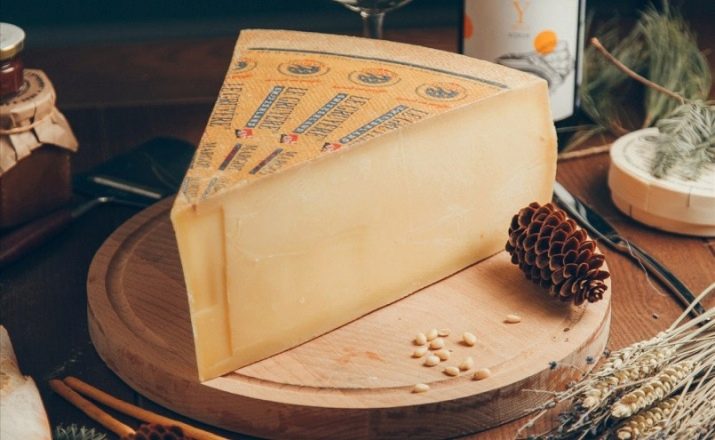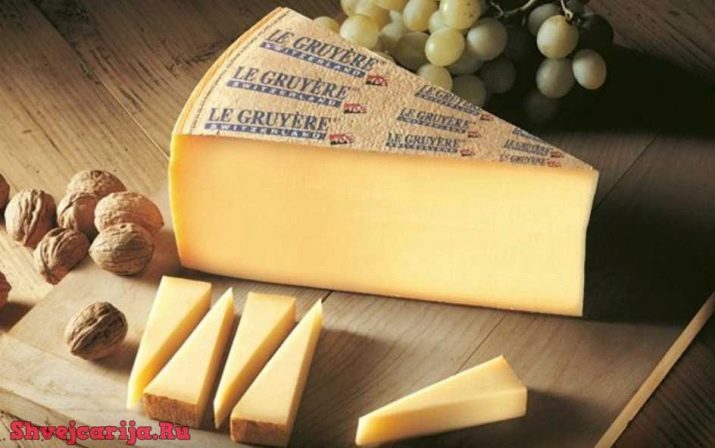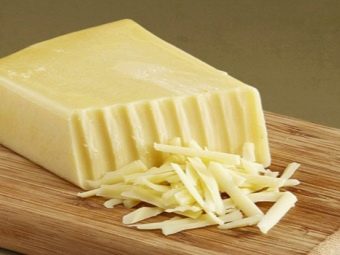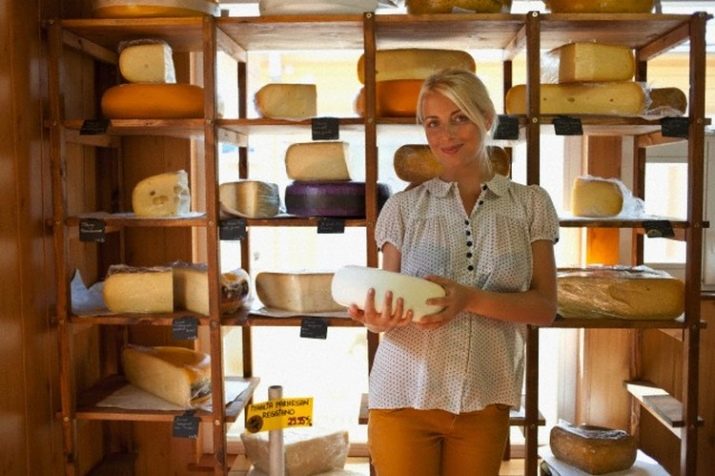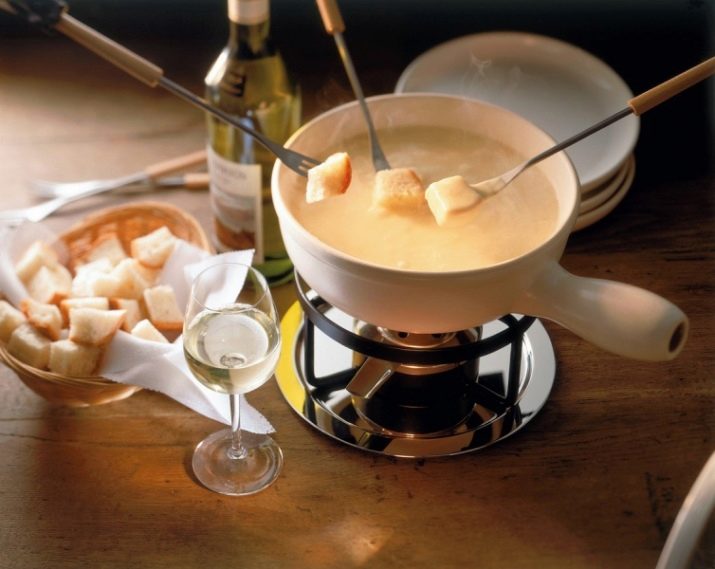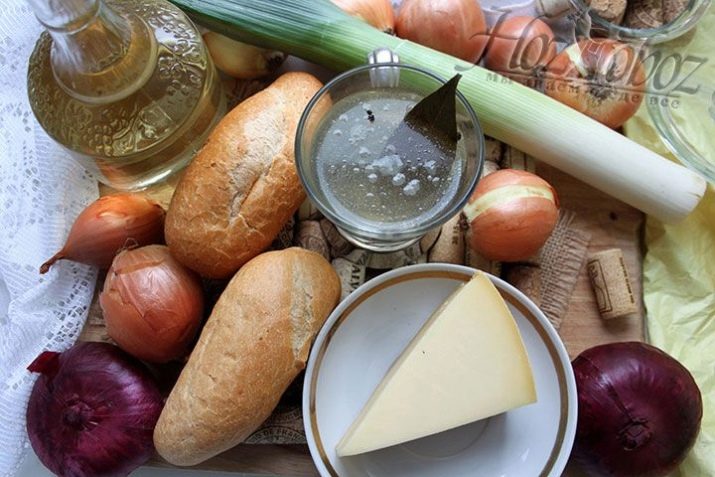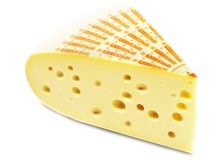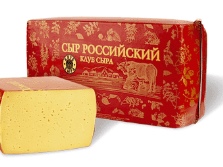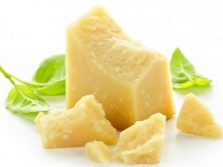Cheese Gruyere: calorie content and composition, use in cooking
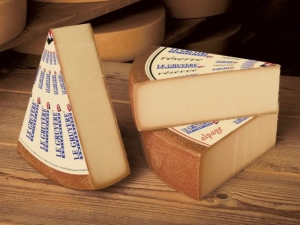
The phrase "Swiss cheese" has long been fixed in the mind as an elite, best quality cheese. Few cheeses can boast such a high score and recognition. Only a high-quality product, manufactured according to a strictly fixed technology and with enhanced control over its observance, may be called Swiss.
What kind of cheese is that?
These products include Gruyere cheese. Although this cheese has recently received the official name of Swiss cheese, only since 2001 it rightfully belongs to the class of elite cheeses. It began to be made in the XI century, after another six centuries, they actively returned to this issue and continued to develop the recipe. For this cheese, France and Switzerland were in fierce debate, proving that they are the birthplace of this elite product. In 2001, Switzerland was able to obtain the status of AOC, providing for strict control of the place of production of this cheese and securing a monopoly.
France produced the same Comte and Beaufort cheeses using the same technology. The French and Swiss versions are distinguished by some details - these are small holes and a more delicate texture in French cheeses, while Gruyere should have no holes at all, it belongs to the class of hard.
For its natural taste, calorie content, fat content and unusual notes, Gruyere cheese received four times the highest award at the competition of cheese makers.
Gruyere cheese can only be called if it was produced in Switzerland and only in the regions of Vaud, Jura, Neuchâtel, Friborg, Bern.
Like almost all Swiss cheeses, it was named after the place where it was produced. You can argue about taste for a long time, if you do not know its features. At various times, it is sweetish, salty, salty, mature and old. Young cheese, about five months old, has a sweetish taste, at eight months - salty, at nine months - mature, rich nut-fruit aroma, older than 1 year old cheese with a rich and more tart taste. He is considered the most valuable, expensive and is called "Reserve" or "Premium". It is among the fat and high-calorie.
A distinctive feature of this product is a subtle nut-fruity aroma, which at different times appears more or less saturated. Gruyere himself changes his texture over time from softer and more delicate to dense with a more saturated tart taste. As noted above, this kind of cheese can be produced only in Switzerland. According to strictly controlled technology, 1 kg of cheese is obtained from 12 liters of the best Alpine milk of those happiest cows who graze all day on the fertile meadows and eat fresh, rich in healthy substances, juicy and young grass.
The manufacturing process begins with the collection of morning and evening milk, which is placed in the copper basin. To it is added a leaven of dairy bacteria and rennet (an extract from the calf's stomach containing the necessary enzymes) and at a temperature of +34 degrees support this mixture until curd and whey are formed. Further, the special knives chop the curd to the size of rice grain, which gives it subsequently a unique structure and taste. After the temperature is raised to +54 degrees and the mass is weary until done, determining it by adhesion and consistency. This time on technology is about 45 minutes.
After obtaining the necessary consistency, the whey is drained, and the basis for the future cheese is pressed in special forms with the brand name under the yoke of 900 kg for about 20 hours. Next, the cheese heads are soaked in a saline solution at a 22% concentration for about a day, while the product receives approximately half of the required salt. Now you need to wait for its aging. It should mature in conditions as close as possible to the basement. After all, they provide the cheese a consistency, structure and taste.
Humidity is acceptable within 95–97%, temperature - + 13– + 14 degrees Celsius.Heads must be periodically turned over and rubbed with salt. It is at this time that a brown crust-shell is formed on the cheese. The heads form 55–65 cm in diameter, the weight of cheese reaches 25–40 kg. Therefore, it goes on sale sliced wedge-shaped.
In principle, such a product can already be consumed in a month, but according to the technology, it will still be available after five months of aging. The fact is that after five months of ripening young cheese passes a strict selection for quality control and only then goes on sale. Most are left to ripen further. The older the cheese, the fatter and more nutritious it is.
In Europe, this cheese is often used with varying degrees of aging in the preparation of many dishes. But still, according to the recipe, this Gruyere is a hard cheese, which has a ripening period of more than one year.
Composition and calorie
Elite and popularity of this cheese determines not only its recipe, but also its composition. The value of this product is determined by the freshness and naturalness of the milk used in the preparation. This means that all enzymes and nutrients are not destroyed by such heat treatment. That is, it contains milk, beneficial bacteria from the dairy starter, enzymes from the calf stomach (rennet) and salt.
However, this cheese is rather calorie and fatty. 100 g of the product contains 396 kcal, 27 g of protein, 31 g of fat, 0 g of carbohydrates, which means rapid saturability of this product.
Benefit and harm
The composition of the cheese Gruyere talks about its benefits. These are enzymes, milk fat, microelements, minerals, vitamins A, B, D, E, K, PP. It is noteworthy that in such a product contains about 9 times more nutrients than milk, which is used for its manufacture. Cheese is rich in vitamins A, P, retinol, B1, B2, B4, B5, B6, B9, B12, D, E, K. And also its constant satellites are macronutrients: K Ca, Mg, Na, P and microelements: zinc , phosphorus, iron, manganese, selenium, copper.
The naturalness of the product has provided it with essential carbohydrates, essential and non-essential amino acids, saturated fatty acids and polysaturated fats.
Thanks to this rich content, the benefits of Gruyere cheese are obvious:
- strengthens joints and bones;
- promotes immunity;
- quickly restores the strength of the sick, elderly, athletes;
- replenishes energy reserves during exercise;
- fights depression, insomnia, nervous conditions;
- increases hemoglobin level in the blood;
- fights caries, strengthens teeth;
- increases the pressure.
Due to the high calcium content in the product, it is indispensable for smokers, whose calcium absorption in the body deteriorates with age. And also it will be useful for lactating and pregnant women. It will help athletes recover from stress and gain additional energy for the body. But not all natural products are equally beneficial for everyone.
This cheese is not recommended for people with high blood pressure, acute or chronic pyelonephritis, as well as those who are allergic to dairy products. It is not recommended for people who are overweight, because it is quite fat and high in calories.
Important! This Gruyere cheese is produced only in Switzerland, but because of the high price (from 30 pounds per 1 kg) on the table of the Russian consumer, it gets extremely rare. Price in stores ranges from 200 to 400 rubles per 200 grams of product.
Varieties and popular brands
Le Gruyère Switzerland AOC Alpage is very popular. The peculiarity of this variety is that it is made only from Alpine milk of cows that are free-range. It is produced in small quantities and in smaller heads. The Belarusian manufacturer Postavy Gorod took a chance and developed an analogue of the Swiss luxury product. Belarusian cheeses have long been known to consumers as high-quality, natural and very tasty.And this time they used new high-tech equipment and old recipes to become innovators and conquer the Russian market.
Popular Russian brands did not dare to make this cheese, because the technology is very tough, and the aging period of the cheese is large and complex. The main component in the manufacture is milk, so at the factory it passes the strictest quality control is not pasteurized and this achieves a high similarity of the Belarusian product with the original. According to the reviews of the most demanding buyers of Belarusian cheese Gruyère, it is worth noting that it has a nut-and-fruity notes, in its texture and structure is very similar to the original, it has the same fat and caloric content as the original. And therefore deservedly takes the first places in the survey of buyers.
Cooking Application
Cheese Gruyere is fat and high-calorie, which is an indisputable advantage when cooking many dishes in cooking. With its use there are many recipes.
Fondue
The main delicacy of the Swiss and French using this cheese is fondue. They dip bread, vegetables, gherkins, potatoes, meat and much more into melted cheese. They put any ingredient on long thin forks and dip them in hot cheese sauce. So, to make fondue, you need the following ingredients:
- dry wine - 200 g;
- garlic - a few cloves;
- Gruyere cheese - 250 g;
- Emmental cheese - 250 g;
- vodka - 40 ml;
- lemon juice - 1 tablespoon;
- corn meal - 30–40 g;
- nutmeg and white pepper to taste.
Wine, lemon juice and garlic pressed through a press should be placed in a special fondue bowl and heated. Cheese should be grated and added to the wine when it is quite hot. It is forbidden to boil. It is recommended to use a wooden spatula for stirring. You should wait for the cheese to melt and then add the flour mixed in vodka to the fondue. Everything should be slowly stirred and simmer for about three minutes. At the end add nutmeg and white pepper. The dish is ready.
The main thing is to follow the sequence and proportions. If, however, the dish is too liquid, add some more flour or starch, and if it is thick, add white wine. Cooking should be in a pan with a non-stick coating. Fondue is served hot, so to maintain the temperature, the dishes with cheese sauce are heated with a candle or a hot-water bottle from below.
Cheese soup with croutons
The French consider Gruyere cheese indispensable in their classic cheese soup. It perfectly emphasizes the taste and preserves the necessary consistency. The following ingredients are required to make cheese soup with croutons:
- red onion - 400 g;
- leek - 120 g;
- beef, chicken or other non-fat broth - 1 l;
- dry wine - 100 ml;
- vegetable oil - 15–20 ml;
- garlic - 1 tooth;
- butter - 20 g;
- Gruyere cheese - 50 g;
- bay leaf, thyme, salt, pepper to taste;
- bread croutons.
It is necessary to cut red onion into thin semi-rings and thin strips of leek. It is necessary to chop the garlic with a knife or through a press. Thyme leaves must be torn off the stem. In a bowl with a thick bottom should pour vegetable oil, add butter to it. The fire should be small. When butter is melted, add red onions, in 5–7 minutes - leeks. And leave to languish for about 30 minutes.
Next, you need to add garlic, thyme and wine. When the mixture is slightly heated, add warm broth. Wait for boiling, add spices and salt. After boiling the fire should be reduced to small and cook for 20-25 minutes. It remains to get the heat-resistant soup plates, pour the soup into them, put the croutons on top, sprinkle them with cheese and send to the oven for 5-10 minutes. And that's all, a piece of France will be at every house.
Important! Due to its excellent melting properties and strong elasticity, Gruyère cheese is often added to various pastes, filled with salads, baked pizza with it, created recipes for various casseroles. He is a frequent guest of the cheese plate due to its rich and bright taste.
What can be replaced?
Not all housewives will be able to find Gruyere cheese on the shelves of shops, so many are interested in what can be replaced in the recipe. You can answer this question based on its properties. It is solid, with a pronounced taste, so you need to look for an analogue with similar properties. Suitable as Emmental, Jarlsberg, Russian, and Parmesan.
How to make Gruyere cheese at home, see below.

